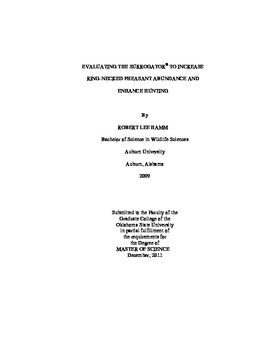| dc.contributor.advisor | Davis, Craig A. | |
| dc.contributor.author | Hamm, Robert Lee | |
| dc.date.accessioned | 2014-04-15T21:59:44Z | |
| dc.date.available | 2014-04-15T21:59:44Z | |
| dc.date.issued | 2011-12-01 | |
| dc.identifier.uri | https://hdl.handle.net/11244/9172 | |
| dc.description.abstract | I studied the pre- and post-release survival and habitat use of ring-necked pheasant (Phasianus colchicus) chicks released from a device called a Surrogator� from late spring to fall of 2009 and 2010. To accomplish this I banded all released chicks for future identification and used radio-telemetry to track a proportion of the chicks as they dispersed from the units. During this time I also monitored invertebrate and predator abundances on both treatment and control fields. During the pheasant hunting seasons of 2009-2010 and 2010-2011 I surveyed hunters for demographic data, and for impressions of surrogator-reared pheasant from those who harvested banded birds. During hunts, I monitored hunters on treatment and control fields to determine hunter behavior and recorded any banded birds harvested. In-surrogator survival was typically high with and average of 85% � 5 and 79% � 8 in 2009 and 2010 respectively. Post-release mortality rates was generally high, especially for the first 2-3 weeks. The mean survival rate to 12 weeks post-release was 0.18% � 0.06. Pheasant habitat selection typically did not differ from randomly paired points, except for the selection of slightly more dense vegetation. Predator abundances did not seem to be effected by the presence of released chicks. Hunters that came to the study fields were typically male, middle age, and experienced. The hunters who harvested banded birds typically had a positive impression of them and considered them closely comparable to wild birds. Band return-rates were 2% in 2009-2010 and 16% in 2010�-2011. | |
| dc.format | application/pdf | |
| dc.language | en_US | |
| dc.publisher | Oklahoma State University | |
| dc.rights | Copyright is held by the author who has granted the Oklahoma State University Library the non-exclusive right to share this material in its institutional repository. Contact Digital Library Services at lib-dls@okstate.edu or 405-744-9161 for the permission policy on the use, reproduction or distribution of this material. | |
| dc.title | Evaluating the Surrogator to Increase Ring-Necked Pheasant Abundance and Enhance Hunting | |
| dc.type | text | |
| dc.contributor.committeeMember | Elmore, R. Dwayne | |
| dc.contributor.committeeMember | Guthery, Fred S. | |
| osu.filename | Hamm_okstate_0664M_11698.pdf | |
| osu.college | Agricultural Sciences and Natural Resources | |
| osu.accesstype | Open Access | |
| dc.description.department | Department of Natural Resource Ecology and Management | |
| dc.type.genre | Thesis | |
| dc.subject.keywords | chicks | |
| dc.subject.keywords | hunting | |
| dc.subject.keywords | radio-telemetry | |
| dc.subject.keywords | ring-necked pheasant | |
| dc.subject.keywords | surrogator | |
